Recent theatrical viewing

I don’t know what goes through the minds of the people who run the corporate chains, but the theatre experience just seems to get worse all the time. I’ve dragged myself out to see a movie four times so far this year, and while I’ve appreciated the movies themselves (for the most part), the two most recent experiences just made me want to hunker down and watch at home.
I hadn’t been to the Landmark Grant Park multiplex in ages and they’ve gone through major renovations. Supposedly to make it more appealing, they’ve stripped out large numbers of seats and installed massive recliners with about three feet of leg room. A guy sitting in the seat next to me said “aren’t these great?” and I commented that these seats were likely to make me fall asleep. He laughed and said that had happened to him. When the movie started, he extended his recliner to full length, drew up his feet and proceeded to move his knees back and forth sideways; this fidgeting continued throughout the movie, a constant distraction in my peripheral vision … until, that is, he fell asleep and started softly snoring. This wasn’t anything recognizable as the theatre experience, but was rather like being trapped in some stranger’s basement rec-room. When the company puts more effort into unnecessarily elaborate seats than it does into the experience of watching the movie, you know they’ve forgotten why they exist in the first place.
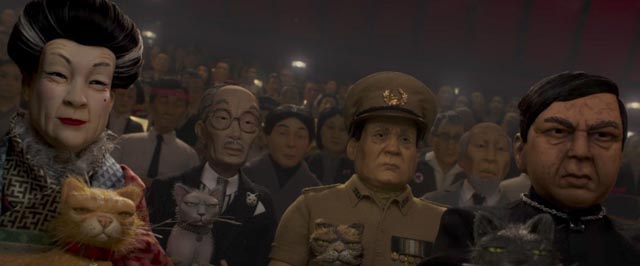
More recently, at the Cineplex at Polo Park (the horrors of which I’ve written about here previously), I’d been raptly watching Wes Anderson’s Isle of Dogs only to be ripped out of the experience prematurely – as soon as the director credit came on screen, the movie was abruptly turned off. That was it. You know there are at least five minutes of end credits on a big animated feature, sometimes closer to ten, and it’s fairly common practice for those credits to contain additional moments of animation. I’ll have to wait until the film is released on disk to discover whether I missed anything, but the sheer obnoxious disregard displayed towards the audience – and the lack of respect for the movie itself – instantaneously transformed what had until then been close to ecstatic pleasure into a mood of sour anger as I left the theatre.
For a century, the owners and managers of theatres prided themselves on providing a special and rewarding experience to their patrons. Today, faceless corporations take your money and say “fuck you!” to your face.
*
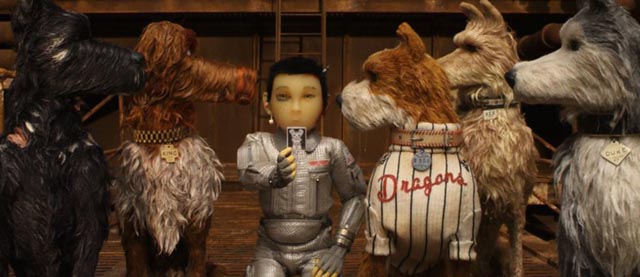
Isle of Dogs (Wes Anderson, 2018)
I like all forms of animation, but have a special affection for stop-motion, an incredibly complicated and painstaking art. Although it seemed surprising when it was announced almost ten years ago that Wes Anderson was making an animated feature (The Fantastic Mr. Fox, 2009), the finished film seemed like an inevitable development in his career. In retrospect, his attention to pictorial details and minutely observed (and for some viewers irritatingly quirky) characters were obviously perfectly suited to animation, where everything needs to be invented down to the smallest detail and where characters are both highly individual and archetypal.
Now, almost a decade later, Anderson has created a second, even more elaborate animated feature. Isle of Dogs (2018) is recognizable as his work in its visual invention and its comic observation of behaviour, but it’s stranger and darker in tone. It draws on Japanese manga and anime for its world-building (a stylized future which evokes an imagined Japan rooted in our Western experience, only partially comprehended, of that country, its myths and history), beginning with a prologue which establishes an ancient conflict between a powerful human clan and the race of dogs. In the film’s present, that clan now holds political power and a plan has been set in motion to commit what amounts to dog genocide; a canine disease has been created in a lab and released into the city of Megasaki, justifying the exile of all dogs to an archipelago of garbage islands.
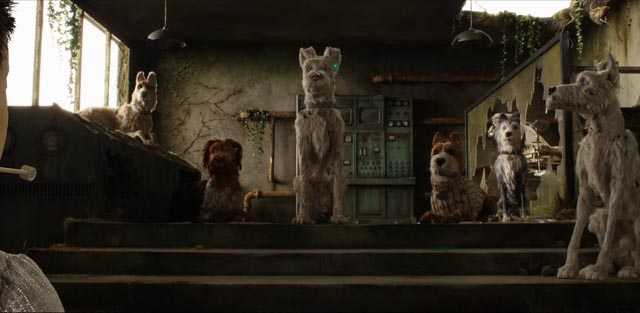
The centre of the story is the quest of Atari (voice of Koyu Rankin), the young adopted nephew of Mayor Kobayashi (voice of Kunichi Nomura), the political leader, to get to the islands and find his dog companion. The tribes of dogs which scavenge for survival among the mounds of trash fight amongst themselves, while many distrust humans. But a small group led by Chief (voice of Bryan Cranston) aid the determined boy even as the Megasaki authorities try to capture him while finalizing their plans to kill all the dogs.
Meanwhile, a group of students have formed a resistance which is working to expose the truth behind the disease infecting the dogs and prevent the Mayor’s genocidal plans from being carried out. As Atari gets closer to finding his lost companion, the film becomes darker with its revelations of the brutality inflicted on the dogs by the Mayor and his forces … and the vividness of the dogs’ characters emphasizes the larger theme of racism, “othering” and the roots of genocidal violence. Which is a pretty heavy load for an animated feature to carry, but not unprecedented in anime, which is so often much darker and more adult-oriented than Western animation.
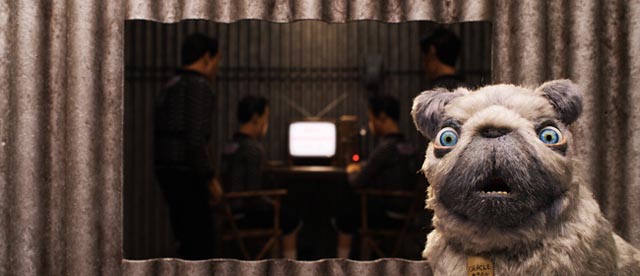
These dark themes are rendered through finely drawn characters and imaginatively designed visual details (filled with comic touches). Anderson (and co-writers Roman Coppola, Jason Schwartzman and Kunichi Nomura) foreground the linguistic and cultural issues raised by their “appropriation” of Japanese storytelling forms by centring the film on the dogs’ point of view; while their language is fully translated into English, the human characters’ Japanese dialogue is frequently left untranslated, or delivered through intermediaries – occasional subtitles or, more often, on-screen translators. This approach expresses both a real affection for anime/manga and an acknowledgement that the genre and its underlying cultural roots remain only partially knowable for these Western filmmakers and a Western audience.
*

The Death of Stalin (Armando Iannucci, 2017)
By coincidence, the film I saw just a few weeks before Isle of Dogs is also a comedy which deals with the dark side of politics and the issue of genocidal violence.
No one is better at finding the dark humour in politics than Armando Iannucci. From his many years in British television which culminated in the savagely funny The Thick of It (2005-2012) and its movie off-shoot In the Loop (2009) to his U.S. endeavour Veep (2012-2017), Iannucci has dissected the worst tendencies of those who seek power. Which is why what at first glance seems like a really odd choice of subject for his new film actually fits perfectly with the rest of his work.
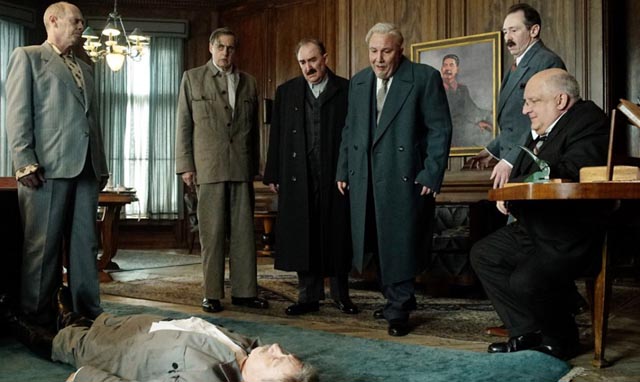
The Death of Stalin (2017) treads even more closely to the edge of bad taste than anything Iannucci has previously done. Stalin was a genocidal monster who surrounded himself with a sycophantic crowd of like-minded enablers. This bloody-handed clique slaughtered millions in their efforts to build a “workers’ paradise”, using every tool available to imprison and kill those they deemed obstacles to their noble aims. By the time Stalin died in 1953, the leaders of the Communist Party had internalized their leader’s paranoia, living in fear themselves even as they stirred endless fear in the population they ruled over.
Iannucci’s film (based on a comic book by Fabien Nury and Thierry Robin) balances the comic absurdity of this bunch as they jockey for position and scheme against each other with the grim brutality of the world they have created. Written with wit and energy and enthusiastically performed by a terrific cast, their buffoonery fueled by their own terror, the comedy is constantly undercut by the violence they perpetrate – not only do they order torture and murder, they are personally involved in these crimes. The result is a very funny movie which continually calls into question the laughter it provokes. The world depicted is one twisted beyond reason; the laughter emerges from madness and fear. And, although it presents an extreme case, it illuminates the inherent awfulness of those driven by a desire for nothing more than political power for its own sake.
*
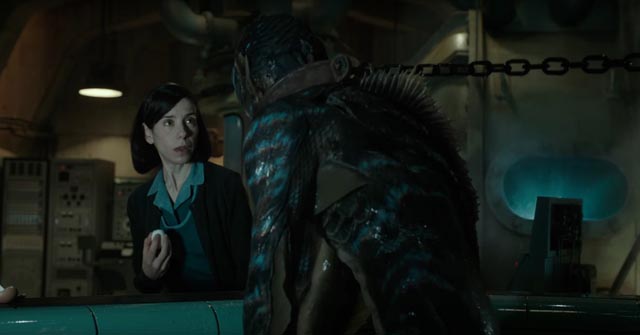
The Shape of Water (Guillermo del Toro, 2017)
The Death of Stalin ends with Nikita Kruschev having consolidated his hold on power, presaging a brief loosening of political oppression in the Soviet Empire which nonetheless was accompanied by an intensifying of the Cold War. Guillermo del Toro’s Oscar-winning The Shape of Water (2017) takes place in a fantasy version of that world, at the dawn of the space age with the U.S. and the U.S.S.R. trapped in a cycle of paranoia and violence. Both sides justify the violence with an unshakable conviction of moral and political righteousness which transforms them into monsters devoid of self-awareness.
The movie centres on several outsiders, misfits who exist on the fringes of this paradoxically monolithic world, all but invisible to the authorities which deny them any degree of power or autonomy. The protagonist is a mute woman named Elisa (Sally Hawkins) who lives in a large rundown apartment above a movie theatre, her next door neighbour a shy and insecure commercial artist (Richard Jenkins) who also happens to be a gay man too timid to live openly as who he is. Elisa works as a night shift cleaner at a dank government facility, affectionately protected by a fellow worker named Zelda (Octavia Spencer).
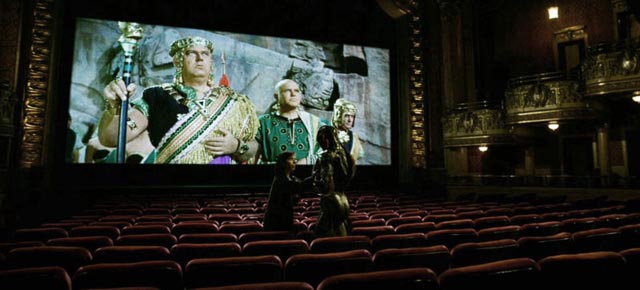
One day agents arrive with something valuable which they discovered in South America, and which they believe will aid them in conquering the physical limitations which stand in the way of space exploration. This is essentially the Creature from the Black Lagoon (Doug Jones), an amphibian which embodies the other characters’ otherness. Elisa is fascinated and secretly develops a bond with the animal, introducing it to human food and the pleasures of music. When she sees the government agents torturing him and learns that they plan to kill and dissect him, she hatches a plan to break him out of the lab and release him back into the wild.
Elisa’s low status actually facilitates the operation because she’s beneath the notice of the authorities. She’s also helped by a Russian agent working inside the lab who recognizes the intrinsic worth of the amphibian and has himself been ordered by his bosses to destroy it before the Americans can make use of it. Set against those who respect the creature are the agent Richard Strickland (Michael Shannon), a sadistic bastard who enjoys inflicting pain at work while playing the suburban dad to a wife and kids at home.
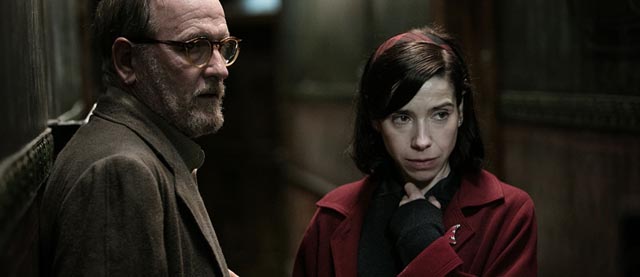
I actually saw The Shape of Water several months ago (before it won all those Oscars), but was reluctant to write about it because, while I appreciated its atmosphere and fine performances and del Toro’s typical attention to visual details, I was vaguely disappointed. I recently watched it again on disk, and found that it required some effort to stay with it to the end. I think the problem is that it simply has no depth … everything is right there, plainly visible on the surface, so there’s no sense of mystery or discovery. Its symbolism is obvious and despite those lush visual textures it doesn’t create a convincing reality – particularly on a second viewing, it’s impossible to swallow the freedom Elisa has to play out her secret relationship with the creature inside the lab. Del Toro has put all his creative effort into the look of the film and neglected the requirements of a plausible narrative. I really wanted to like it, but for me it’s the least engaging of all his films (with the exception of the overblown nonsense of Hellboy 2).
Comments
Like you I find little joy in going to the theater or The Shape Of Water.
If I think too much about how movie-going has changed since the days I’d go five or six or even more times a week, and sometimes sit through the same movie twice in a row, I get depressed.